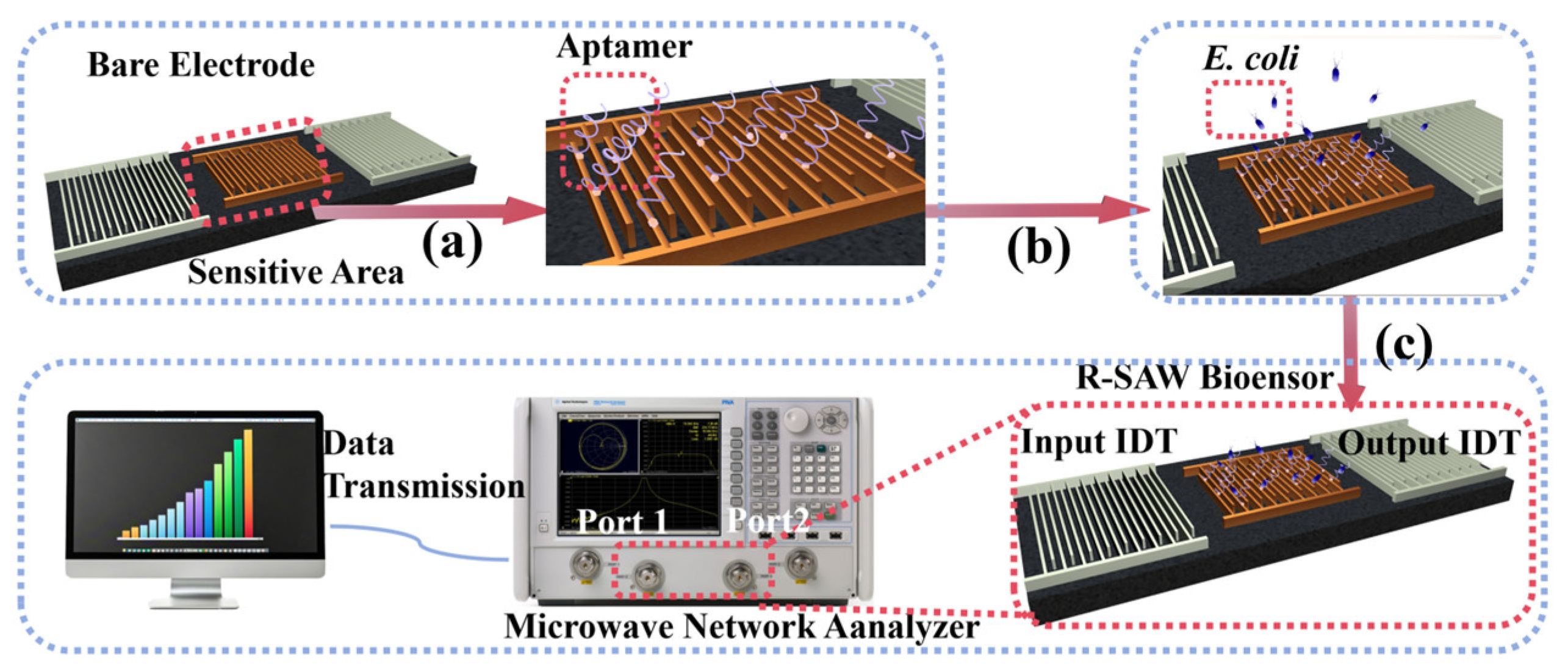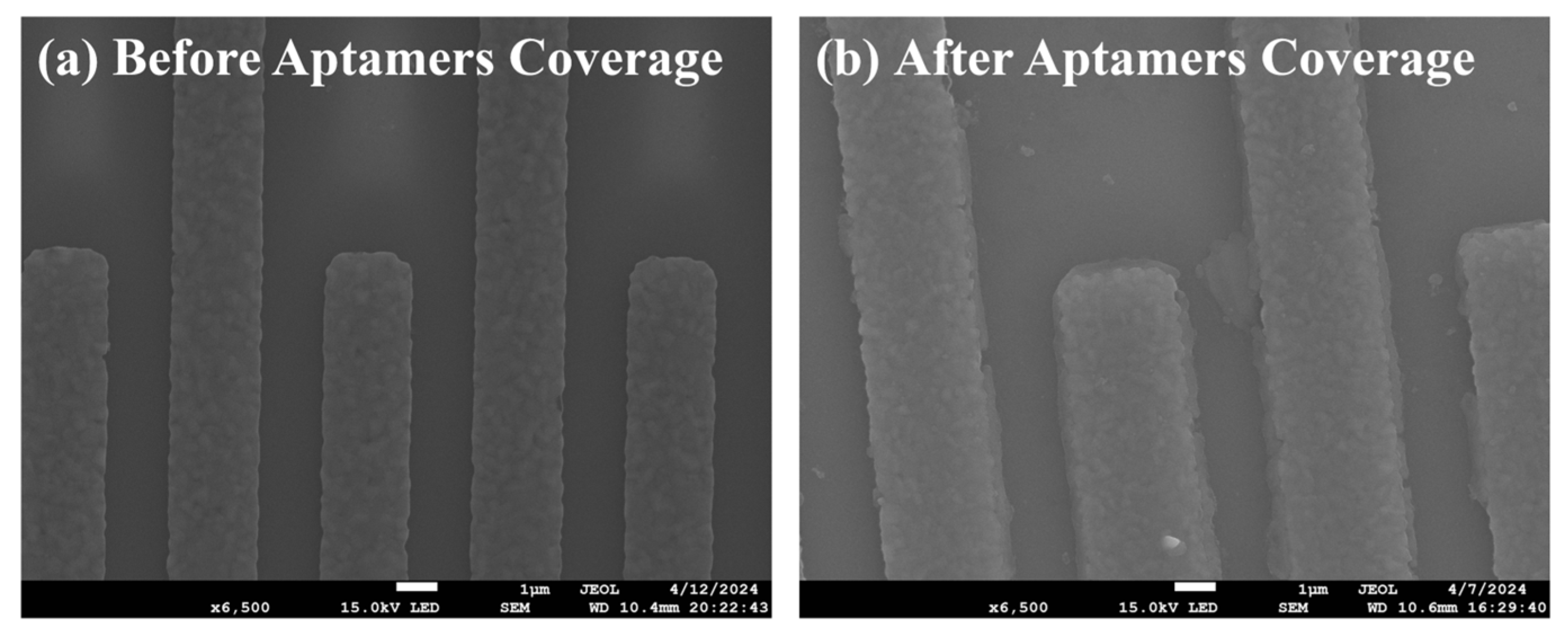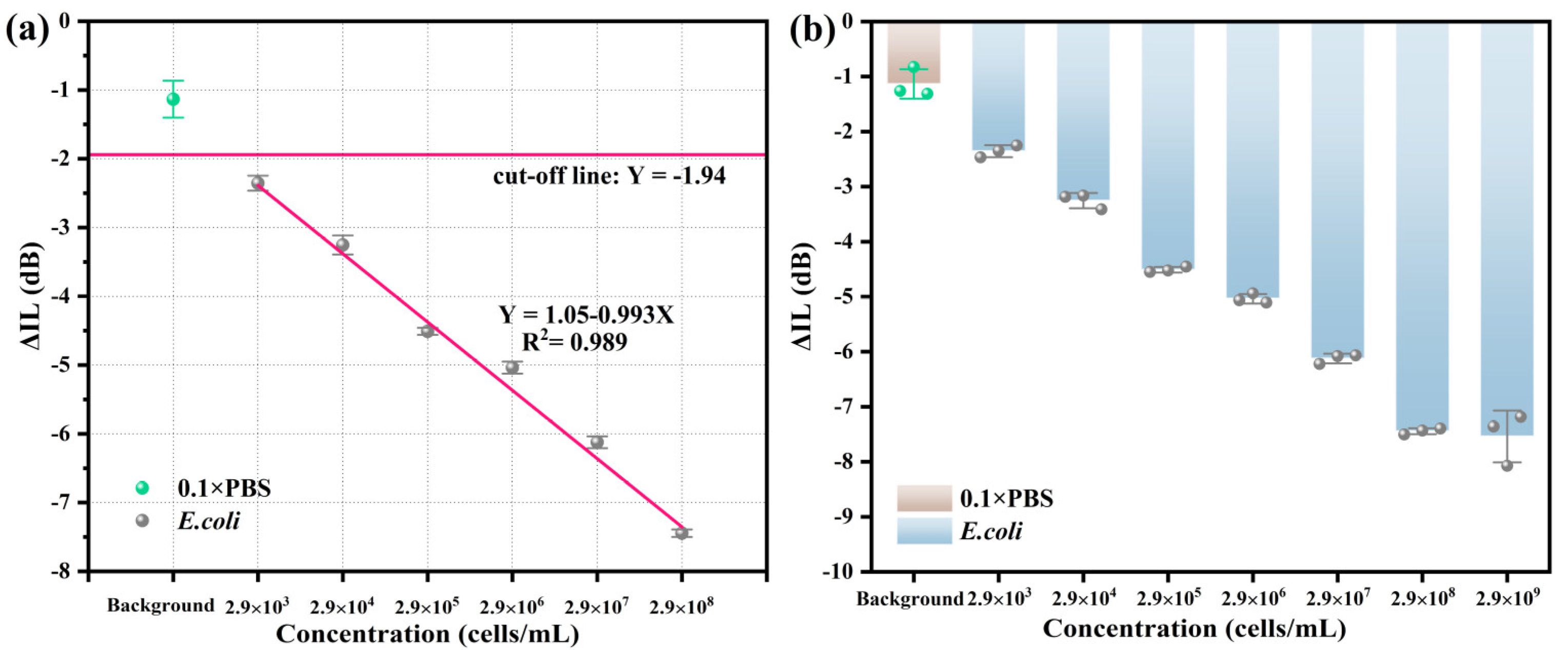A Biosensor Based on Commercial R-SAW for Rapid and Sensitive Detection of E. coli
Abstract
1. Introduction
2. Materials and Methods
2.1. Materials and Equipments
2.2. Optimization of the Aptamer
2.3. Pretreatment of the Biosensor
2.4. Functionalization and Detection of the Biosensor
2.5. Pretreatment of the Actual Samples
3. Results and Discussion
3.1. Characterization of the R-SAW Biosensor
3.2. Dose Response of the R-SAW Biosensor
3.3. Specificity of the R-SAW Biosensor
3.4. Stability and Actual Sample Detection of the R-SAW Biosensor
4. Conclusions
Supplementary Materials
Author Contributions
Funding
Institutional Review Board Statement
Informed Consent Statement
Data Availability Statement
Conflicts of Interest
References
- Zeng, Y.J.; Yuan, R.; Fu, H.; Xu, Z.L.; Wei, S. Foodborne pathogen detection using surface acoustic wave biosensors: A review. RSC Adv. 2024, 14, 37087–37103. [Google Scholar] [CrossRef] [PubMed]
- Abbas, N.; Song, S.H.Y.; Chang, M.-S.; Chun, M.-S. Point-of-care diagnostic devices for detection of Escherichia coli O157:H7 using microfluidic systems: A focused review. Biosensors 2023, 13, 741. [Google Scholar] [CrossRef] [PubMed]
- Jaffee, S.; Henson, S.; Unnevehr, L.; Grace, D.; Cassou, E. The Safe Food Imperative: Accelerating Progress in Low and Middle-Income Countries; Agriculture and Food Series; World Bank: Washington, DC, USA, 2019. [Google Scholar] [CrossRef]
- Cui, W.J.; Wang, J.; Ding, C.; Van Cappellen, P.; Ho, E.A.; Ren, C.L. A functionalized microwave biosensor for rapid, reagent-free detection of E. coli in water samples. Biosens. Bioelectron. 2025, 278, 117334. [Google Scholar] [CrossRef]
- Ahmed, M.W.; Gul, K.; Mumtaz, S. Recent advances in cold atmospheric pressure plasma for E. coli decontamination in food: A review. Plasma 2025, 8, 18. [Google Scholar] [CrossRef]
- Basu, D.; Tumer, N.E. Do the a subunits contribute to the differences in the toxicity of Shiga toxin 1 and Shiga toxin 2? Toxins 2015, 7, 1467–1485. [Google Scholar] [CrossRef]
- Zhuang, L.L.; Gong, J.S.; Zhao, Y.; Yang, J.B.; Liu, G.F.; Zhao, B.; Song, C.L.; Zhang, Y.; Shen, Q.P. Progress in methods for the detection of viable Escherichia coli. Analyst 2024, 149, 1022–1049. [Google Scholar] [CrossRef]
- Jin, C.H.; Xiao, Y.H.; Wu, H.; Ji, X.F.; Li, G.; Shuai, J.B.; Yang, P.F.; Xiong, L.N. Human-model interaction-based decision support system for optimizing food safety assessment. Food Res. Int. 2025, 208, 116156. [Google Scholar] [CrossRef]
- Ten, S.T.; Hashim, U.; Gopinath, S.C.B.; Liu, W.W.; Foo, K.L.; Sam, S.T.; Rahman, S.F.A.; Voon, C.H.; Nordin, A.N. Highly sensitive Escherichia coli shear horizontal surface acoustic wave biosensor with silicon dioxide nanostructures. Biosens. Bioelectron. 2017, 93, 146–154. [Google Scholar] [CrossRef] [PubMed]
- Zaidan, L.A.; Novodchuk, I.; Xu, A.H.; Nica, A.; Takaloo, S.; Lloyd, C.; Karimi, R.; Sanderson, J.; Bajcsy, M.; Yavuz, M. Rapid, selective, and ultra-sensitive field effect transistor-based detection of Escherichia coli. Materials 2024, 17, 3648. [Google Scholar] [CrossRef]
- Pan, B.F.; El-Moghazy, A.Y.; Norwood, M.; Nitin, N.; Sun, G. Rapid and ultrasensitive colorimetric biosensors for onsite detection of Escherichia coli O157:H7 in fluids. ACS Sens. 2024, 9, 912–922. [Google Scholar] [CrossRef]
- Majowicz, S.E.; Scallan, E.; Jones-Bitton, A.; Sargeant, J.M.; Stapleton, J.; Angulo, F.J.; Yeung, D.H.; Kirk, M.D. Global incidence of human Shiga toxin-producing Escherichia coli infections and deaths: A systematic review and knowledge synthesis. Foodborne Pathog Dis. 2014, 11, 447–455. [Google Scholar] [CrossRef]
- WHO. E. coli. 2018. Available online: https://www.who.int/news-room/fact-sheets/detail/e-coli (accessed on 22 May 2024).
- Zhu, Y.F.; Gu, L.; Yu, J.X.; Yang, J.C.; Zhai, X.J.; Dong, C.; Qian, H.M.; Tan, Z.M.; Pan, H.X.; Liu, J.B.; et al. Analysis on the epidemiological characteristics of Escherichia coli O157: H7 infection in Xuzhou, Jiangsu, China, 1999. J. Nanjing Med. Univ. 2009, 23, 20–24. [Google Scholar] [CrossRef]
- Ishikawa, K.; Yamaguchi, S.; Tsukaoka, T.; Tsunoda, M.; Furuta, K.; Kaito, C. Sulphur-acquisition pathways for cysteine synthesis confer a fitness advantage to bacteria in plant extracts. Environ. Microbiol. 2025, 27, e70126. [Google Scholar] [CrossRef]
- Gill, A.; Huszczynski, G. Enumeration of Escherichia coli O157:H7 in outbreak-associated beef patties. J. Food Prot. 2016, 79, 1266–1268. [Google Scholar] [CrossRef]
- Spagnolo, S.; de la Franier, B.; Davoudian, K.; Hianik, T.; Thompson, M. Detection of E. coli bacteria in milk by an acoustic wave aptasensor with an anti-fouling coating. Sensors 2022, 22, 1853. [Google Scholar] [CrossRef]
- Fu, J.M.; Zhou, Y.F.; Huang, X.L.; Zhang, W.J.; Wu, Y.H.; Fang, H.; Zhang, C.Z.; Xiong, Y.H. Dramatically enhanced immunochromatographic assay using cascade signal amplification for ultrasensitive detection of Escherichia coli O157:H7 in milk. J. Agric. Food Chem. 2020, 68, 1118–1125. [Google Scholar] [CrossRef] [PubMed]
- Tsougeni, K.; Kaprou, G.; Loukas, C.M.; Papadakis, G.; Hamiot, A.; Eck, M.; Rabus, D.; Kokkoris, G.; Chatzandroulis, S.; Papadopoulos, V.; et al. Lab-on-Chip platform and protocol for rapid foodborne pathogen detection comprising on-chip cell capture, lysis, DNA amplification and surface-acoustic-wave detection. Sens. Actuators B 2020, 320, 128345. [Google Scholar] [CrossRef]
- Zhou, W.Q.; Wang, K.; Hong, W.; Bai, C.Y.; Chen, L.; Fu, X.; Huang, T.Y.; Liu, J.Y. Development and application of a simple “easy to operate” propidium monoazide-crossing priming amplification on detection of viable and viable but non-culturable cells of O157 Escherichia coli. Front. Microbiol. 2020, 11, 569105. [Google Scholar] [CrossRef] [PubMed]
- Kim, J.E.; Shin, J.H.; Park, J.P. An engineered antimicrobial peptide as an alternative bioreceptor for the detection of pathogenic Escherichia coli O157:H7. J. Electroanal. Chem. 2024, 953, 118003. [Google Scholar] [CrossRef]
- Lamanna, L.; Rizzi, F.; Bhethanabotla, V.R.; De Vittorio, M. Conformable surface acoustic wave biosensor for E-coli fabricated on PEN plastic film. Biosens. Bioelectron. 2020, 163, 112164. [Google Scholar] [CrossRef] [PubMed]
- Xia, J.F.; Bu, T.; Jia, P.; He, K.Y.; Wang, X.; Sun, X.Y.; Wang, L. Polydopamine nanospheres-assisted direct PCR for rapid detection of Escherichia coli O157:H7. Anal. Biochem. 2022, 654, 114797. [Google Scholar] [CrossRef] [PubMed]
- Rapp, B.E.; Voigt, A.; Dirschka, M.; Rapp, M.; Länge, K. Surface acoustic wave resonator chip setup for the elimination of interfering conductivity responses. Micromachines 2024, 15, 501. [Google Scholar] [CrossRef]
- Wang, T.; Murphy, R.; Wang, J.; Mohapatra, S.S.; Mohapatra, S.; Guldiken, R. Perturbation analysis of a multiple layer guided Love wave sensor in a viscoelastic environment. Sensors 2019, 19, 4533. [Google Scholar] [CrossRef]
- Zhao, Z.; Yin, Y.N.; Cui, B.L.; Hu, F.B.; Wang, W. Low-loss SAW devices for sensing liquid phase based on acoustic model conversion. IEEE Sens. J. 2025, 25, 4341–4349. [Google Scholar] [CrossRef]
- Tretjakov, A.; Syritski, V.; Reut, J.; Boroznjak, R.; Opik, A. Molecularly imprinted polymer film interfaced with surface acoustic wave technology as a sensing platform for label-free protein detection. Anal. Chim. Acta 2016, 902, 182–188. [Google Scholar] [CrossRef]
- Liu, X.; Wang, J.Y.; Mao, X.B.; Ning, Y.; Zhang, G.J. Single-shot analytical assay based on graphene-oxide-modified surface acoustic wave biosensor for detection of singlenucleotide polymorphisms. Anal. Chem. 2015, 87, 9352–9359. [Google Scholar] [CrossRef]
- Han, S.B.; Lee, S.S. Isolation and characterization of exosomes from cancer cells using antibody-functionalized paddle screw-type devices and detection of exosomal miRNA using piezoelectric biosensor. Sensors 2024, 24, 5399. [Google Scholar] [CrossRef] [PubMed]
- Agostinia, M.; Greco, G.; Cecchini, M. A Rayleigh surface acoustic wave (R-SAW) resonator biosensor basedon positive and negative reflectors with sub-nanomolar limit of detection. Sens. Actuators B. 2018, 254, 1–7. [Google Scholar] [CrossRef]
- Zhang, L.; Zhang, S.; Floer, C.; Kantubuktha, S.A.R.; Velasco, M.J.G.R.; Friend, J. Surface acoustic wave-driven enhancement of enzyme-linked immunosorbent assays: ELISAW. Anal. Chem. 2024, 96, 9676–9683. [Google Scholar] [CrossRef] [PubMed]
- Pouya, C.; Nash, G.R. Metamaterial control of the surface acoustic wave streaming jet. J. Phys. D Appl. Phys. 2024, 57, 195303. [Google Scholar] [CrossRef]
- De Simoni, G.; Signore, G.; Agostini, M.; Beltram, F.; Piazza, V. A surface-acoustic-wave-based cantilever bio-sensor. Biosens. Bioelectron. 2015, 68, 570–576. [Google Scholar] [CrossRef]
- Ali, M.H.; Elsherbiny, M.E.; Emara, M. Updates on aptamer research. Int. J. Mol. Sci. 2019, 20, 2511. [Google Scholar] [CrossRef] [PubMed]
- Elskens, J.P.; Elskens, J.M.; Madder, A. Chemical modification of aptamers for increased binding affinity in diagnostic applications: Current status and future prospects. Int. J. Mol. Sci. 2020, 21, 4522. [Google Scholar] [CrossRef]
- Wan, H.X.; Song, D.D.; Li, X.G.; Zhang, D.W.; Gao, J.; Du, C.W. Failure mechanisms of the coating/metal interface in waterborne coatings: The effect of bonding. Materials 2017, 10, 397. [Google Scholar] [CrossRef]
- Badsha, M.A.H.; Khan, M.; Wu, B.L.; Kumar, A.; Lo, I.M.C. Role of surface functional groups of hydrogels in metal adsorption: From performance to mechanism. J. Hazard. Mater. 2021, 408, 124463. [Google Scholar] [CrossRef]
- Song, J.N.; Jin, X.; Wang, X.C.C.; Jin, P.K. Preferential binding properties of carboxyl and hydroxyl groups with aluminium salts for humic acid removal. Chemosphere 2019, 234, 478–487. [Google Scholar] [CrossRef] [PubMed]
- Hu, S.C.; Wang, H.Y.; Li, X.K.; He, W.B.; Ma, J.; Xu, Y.J.; Xu, Y.P.; Ming, W.Y. Recent advances in bioleaching and biosorption of metals from waste printed circuit boards: A review. J. Environ. Manag. 2024, 371, 123008. [Google Scholar] [CrossRef] [PubMed]
- Gao, S.P.; Guisán, J.M.; Rocha-Martin, J. Oriented immobilization of antibodies onto sensing platforms-A critical review. Anal. Chim. Acta 2021, 1189, 338907. [Google Scholar] [CrossRef]
- Zhu, R.Q.; Song, J.P.; Ma, Q.; Zhou, Y.; Yang, J.; Shuang, S.M.; Dong, C.A. A colorimetric probe for the detection of aluminum ions based on 11-mercaptoundecanoic acid functionalized gold nanoparticles. Anal. Methods 2016, 8, 7232–7236. [Google Scholar] [CrossRef]
- Wu, W.H.; Zhang, J.; Zheng, M.Q.; Zhong, Y.H.; Yang, J.; Zhao, Y.H.; Wu, W.P.; Ye, W.; Wen, J.; Wang, Q.; et al. An aptamer-based biosensor for colorimetric detection of Escherichia coli O157:H7. PLoS ONE 2012, 7, e48999. [Google Scholar] [CrossRef]
- Ma, X.C.; Fei, H. The use of metal coordination in peptide and protein research. Prog. Chem. 2016, 28, 184–192. [Google Scholar] [CrossRef]
- He, W.; Ren, X.H.; Liu, J.Y. Corrosion inhibition performance of RNC-n on aluminum alloy surface in alkaline solution. J. Mol. Struct. 2024, 1317, 139107. [Google Scholar] [CrossRef]
- Chang, K.S.; Chang, C.K.; Chen, C.Y. A surface acoustic wave sensor modified from a wireless transmitter for the monitoring of the growth of bacteria. Sens. Actuators B 2007, 125, 207–213. [Google Scholar] [CrossRef]
- Chang, Y.H.; Jang, H.D.; Hsu, C.L.; Chang, K.S. Quantitative determination of Escherichia coli in water sources in the environment using a surface acoustic wave impedance system modified with a syringe filter. Anal. Lett. 2012, 45, 1485–1494. [Google Scholar] [CrossRef]
- Moll, N.; Pascal, E.; Dinh, D.H.; Pillot, J.P.; Bennetau, B.; Rebière, D.; Moynet, D.; Mas, Y.; Mossalayi, D.; Pistré, J.; et al. A Love wave immunosensor for whole E-coli bacteria detection using an innovative two-step immobilisation approach. Biosens. Bioelectron. 2007, 22, 2145–2150. [Google Scholar] [CrossRef] [PubMed]







| Pathogen | Waveforms | Food Sample | Detection Range | LOD | Detection Time | Reference |
|---|---|---|---|---|---|---|
| E. coli | Love wave | Not mentioned | 105–108 cells/mL | 105 cells/mL | <3 h | [1] |
| E. coli | Shear horizontal wave | Not mentioned | 106–109 cells/mL | 106 cells/mL | 2.5 h | [1] |
| E. coli | Not mentioned | Not mentioned | 102–107 cells/mL | 102 cells/mL | 7 h | [45] |
| E. coli | Not mentioned | Not mentioned | 102–107 cells/mL | Not mentioned | 10.8 h | [46] |
| E. coli | Love wave | Not mentioned | Not mentioned | 106 cells/mL | <1 h | [47] |
| E. coli | Rayleigh wave | Watermelon, beef, pure water, and so on | 103–108 cells/mL | 732 cells/mL | 100 s | This work |
Disclaimer/Publisher’s Note: The statements, opinions and data contained in all publications are solely those of the individual author(s) and contributor(s) and not of MDPI and/or the editor(s). MDPI and/or the editor(s) disclaim responsibility for any injury to people or property resulting from any ideas, methods, instructions or products referred to in the content. |
© 2025 by the authors. Licensee MDPI, Basel, Switzerland. This article is an open access article distributed under the terms and conditions of the Creative Commons Attribution (CC BY) license (https://creativecommons.org/licenses/by/4.0/).
Share and Cite
Lv, L.; Xu, Z.; Zhou, Y.; Wu, J.; Zhang, X.; Qi, H. A Biosensor Based on Commercial R-SAW for Rapid and Sensitive Detection of E. coli. Chemosensors 2025, 13, 308. https://doi.org/10.3390/chemosensors13080308
Lv L, Xu Z, Zhou Y, Wu J, Zhang X, Qi H. A Biosensor Based on Commercial R-SAW for Rapid and Sensitive Detection of E. coli. Chemosensors. 2025; 13(8):308. https://doi.org/10.3390/chemosensors13080308
Chicago/Turabian StyleLv, Li, Zhuoer Xu, Yicheng Zhou, Jayne Wu, Xueyong Zhang, and Haochen Qi. 2025. "A Biosensor Based on Commercial R-SAW for Rapid and Sensitive Detection of E. coli" Chemosensors 13, no. 8: 308. https://doi.org/10.3390/chemosensors13080308
APA StyleLv, L., Xu, Z., Zhou, Y., Wu, J., Zhang, X., & Qi, H. (2025). A Biosensor Based on Commercial R-SAW for Rapid and Sensitive Detection of E. coli. Chemosensors, 13(8), 308. https://doi.org/10.3390/chemosensors13080308






